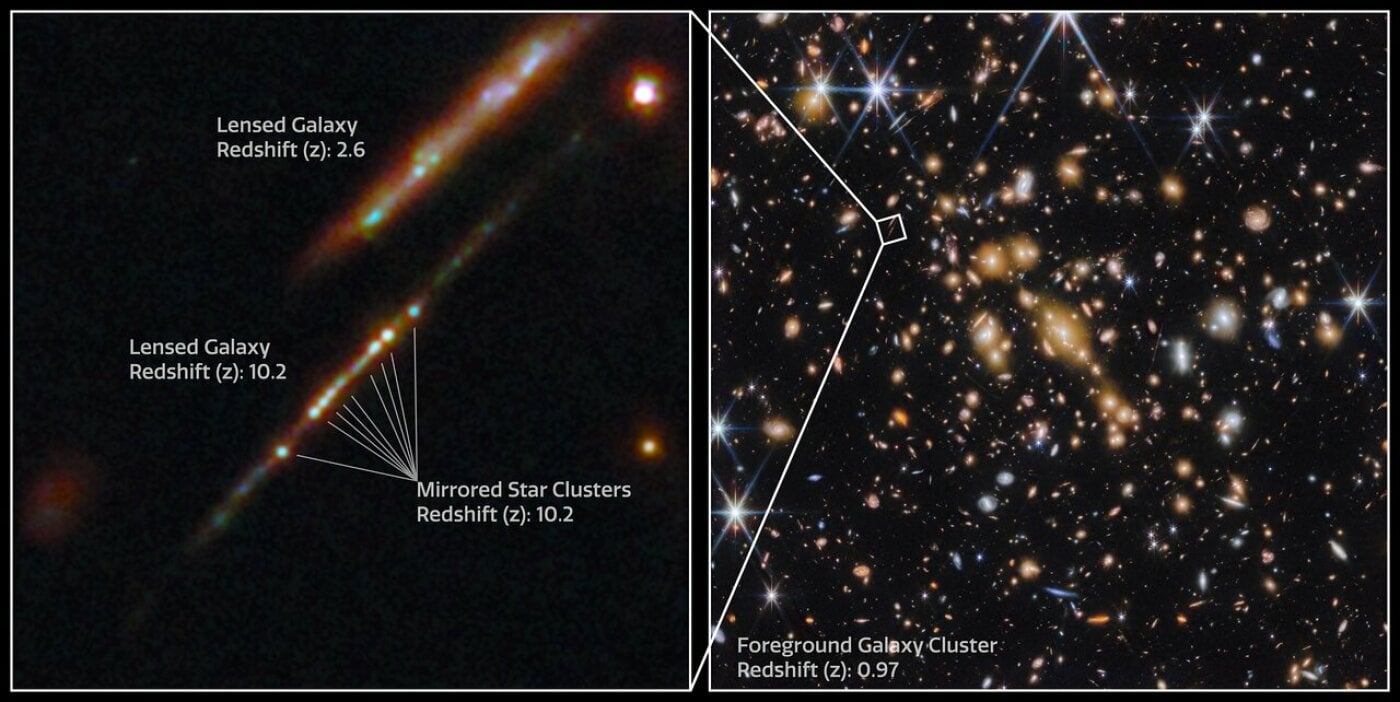Astronomers are getting their money’s worth.
Scientists used the powerful $10 billion James Webb Space Telescope to peer into some of the deepest cosmos, and for the first time captured views of star clusters inside an extremely ancient galaxy. In the images below, you’re viewing these star clusters, which are gravitationally bound groupings of stars, as they existed just 460 million years after the universe’s creation. That’s looking through 97 percent of cosmic time.
This profoundly deep space view was made possible by the double whammy of the Webb telescope’s unprecedented sensitivity — its over 21-foot-wide gold-plated mirrors detect extremely faint sources of light — and a natural phenomenon called a “gravitational lens.” In the foreground sits a massive cluster of galaxies, each containing hundreds of billions of stars, millions of black holes, and perhaps trillions of planets. The combined mass of these galaxies warps space, like a bowling ball sitting on a mattress. It creates a giant magnifying lens.
“Webb’s incredible sensitivity and angular resolution at near-infrared wavelengths, combined with gravitational lensing provided by the massive foreground galaxy cluster, enabled this discovery,” Larry Bradley, an astrophysicist at the Space Telescope Science Institute which manages the Webb telescope, said in a statement.
“No other telescope could have made this discovery,” Bradley, who led the new research published in the science journal Nature, added.
The image below shows this unprecedented cosmic view.
– On right: Almost every object in this image is an entire galaxy (besides the six-pointed stars in the foreground). The white galaxies at center make up the massive galaxy cluster SPT-CL J0615−5746, which creates the gravitational lens.
– On left: Two lensed, or magnified, galaxies. The galaxy on bottom, dubbed the “Cosmic Gems arc,” is shown with a number of separate star clusters. There are actually five, but gravitational lensing can sometimes, under the right viewing alignment from our perch in space, create mirror-images of objects.

The image on left shows Webb’s zoomed in view of two gravitationally lensed galaxies, with the Cosmic Gems arc seen on the bottom.
Credit: ESA Webb / NASA / CSA / L. Bradley (STScI) / A. Adamo (Stockholm University) / Cosmic Spring collaboration
Astronomers are using Webb to learn about the creation of the earliest stars and galaxies — ultimately revealing more about our cosmic history in the Milky Way galaxy. What’s more, astronomers suspect these first galaxies — and massive star clusters inside that may eventually form even larger “globular star clusters” — emitted intense radiation into the early universe, and eventually broke down dense clouds of gas that had saturated space, making it largely opaque. Ultimately, this ended the universe’s “Dark Ages.” Brilliant starlight was no longer hidden; the light was finally unleashed, about 1 billion years after the universe began.
Mashable Light Speed
“No other telescope could have made this discovery.”
Today, with the aid of Webb, we can see these momentous objects from primordial space.
“The surprise and astonishment was incredible when we opened the Webb images for the first time,” Angela Adamo, an astronomer at Stockholm University who also authored the research, marveled in a statement. “We saw a little chain of bright dots, mirrored from one side to the other — these cosmic gems are star clusters! Without Webb we would not have known we were looking at star clusters in such a young galaxy!”
The Webb telescope’s powerful abilities
The Webb telescope — a scientific collaboration between NASA, the ESA, and the Canadian Space Agency — is designed to peer into the deepest cosmos and reveal new insights about the early universe. But it’s also peering at intriguing planets in our galaxy, along with the planets and moons in our solar system.
Here’s how Webb is achieving unparalleled feats, and likely will for decades:
– Giant mirror: Webb’s mirror, which captures light, is over 21 feet across. That’s over two-and-a-half times larger than the Hubble Space Telescope’s mirror. Capturing more light allows Webb to see more distant, ancient objects. As described above, the telescope is peering at stars and galaxies that formed over 13 billion years ago, just a few hundred million years after the Big Bang.
“We’re going to see the very first stars and galaxies that ever formed,” Jean Creighton, an astronomer and the director of the Manfred Olson Planetarium at the University of Wisconsin–Milwaukee, told Mashable in 2021.
– Infrared view: Unlike Hubble, which largely views light that’s visible to us, Webb is primarily an infrared telescope, meaning it views light in the infrared spectrum. This allows us to see far more of the universe. Infrared has longer wavelengths than visible light, so the light waves more efficiently slip through cosmic clouds; the light doesn’t as often collide with and get scattered by these densely packed particles. Ultimately, Webb’s infrared eyesight can penetrate places Hubble can’t.
“It lifts the veil,” said Creighton.
– Peering into distant exoplanets: The Webb telescope carries specialized equipment called spectrographs that will revolutionize our understanding of these far-off worlds. The instruments can decipher what molecules (such as water, carbon dioxide, and methane) exist in the atmospheres of distant exoplanets — be they gas giants or smaller rocky worlds. Webb will look at exoplanets in the Milky Way galaxy. Who knows what we’ll find?
“We might learn things we never thought about,” Mercedes López-Morales, an exoplanet researcher and astrophysicist at the Center for Astrophysics-Harvard & Smithsonian, told Mashable in 2021.
Already, astronomers have successfully found intriguing chemical reactions on a planet 700 light-years away, and as described above, the observatory has started looking at one of the most anticipated places in the cosmos: the rocky, Earth-sized planets of the TRAPPIST solar system.
Topics
NASA
